 Facebook
Facebook
 X
X
 Instagram
Instagram
 TikTok
TikTok
 Youtube
Youtube

I have this noodle idea in my noodle. Korean noodles. I was up here on Convoy looking for the kind of “glass noodles” that my friend Clive, who was stationed in Korea, says are i) ancient, like, they’ve been made and eaten in Korea for around 7000 years; and ii) have a certain slightly sweet flavor, because they’re made from sweet potato starch; and iii) “You’ve got to have them at one of the pochangmachas, the sidewalk stalls that have all the best street food.” Best I can do is Little Seoul, up here in Kearny Mesa. And even though this is Monday night, man! Place is crowded.
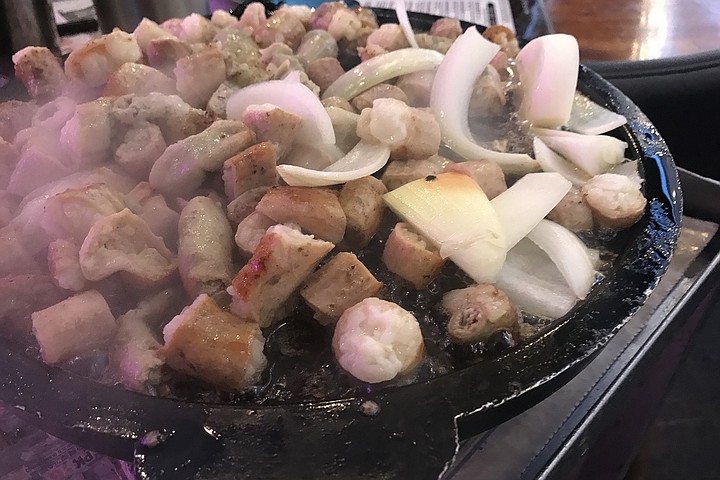
I cross Convoy, and guess what? In a tent outside a place called Song Hak (which doesn’t sound so romantic, but actually means something wildly romantic like “Crane Landing in a Pine Tree”), I see a waitress handing out a little bowl of glass noodles (plus kimchi and yellow radish) as sides to chunks of beef smoking on a black iron disk sitting atop a flaming burner.
Oh yeah. The whole thing of Korean BBQ. It’s so famous, with grills built into the table you sit at, or on portable grills they bring to your table, I’m avoiding that now. Just looking for anything cheap. And wanting to stay here, because the lights in the tent make it look so danged attractive as day fades. Lucky for me: their menu has a ton of individual dishes in the $10-$12 range.
I sit down at a table in the tent. Lots of smoke from hot plates. There is so much tempting BBQ on the menus, including japchae, which is my glass noodles in chopped pork and vegetables. Cost $16.95. Or bulganjang dak gui, broiled and wok-fried chicken with spicy sauce ($18.95). Or teok galbi, grilled beef short rib patties ($16.95 for lunch, $19.95 for dinner), which look kinda like burger patties. Or suuyuk jupsi, steamed beef and pork slices with a garlic chive dipping sauce ($18.95).
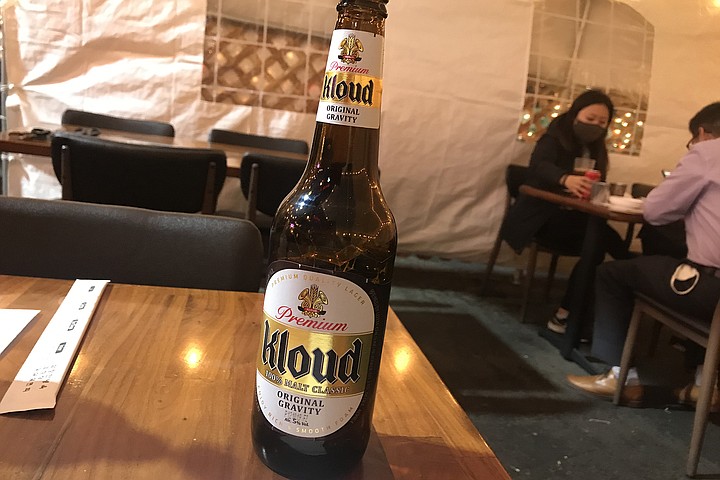
But then, whew, we come down to street food, which is nearer my kind of price. Bibimbop, of course, the famous rice bowl mixed with vegetables and an over easy egg on top costs $11.95 (or $13.95 for dinner). You can add beef or pork bulgogi topping for $4.
So yes, we’re talking a meat-centric diet here. And for the real bargains, we’ve got to look at the big fat udon wheat noodle dishes at the bottom of the page, specially pocha udon. Pocha’s kind of a thing in Korean culture. This is your basic Korean street udon noodle soup. Costs $10.95. So, okay, I came for glass noodles, but as they say, there’s many a slip ’twixt cup and lip. I order the pocha udon, along with a Kloud all-malt Korean beer ($7.95 for a big bottle).
Street food it is. It’s a savory soup with a sweet flap of fish cake drowning in the brown liquid, udon (wheat) noodles swimming below, various veggies, a clump of green onions, and a large half egg. It’s good and interesting, and a reasonable deal for eleven bucks.
Only trouble?
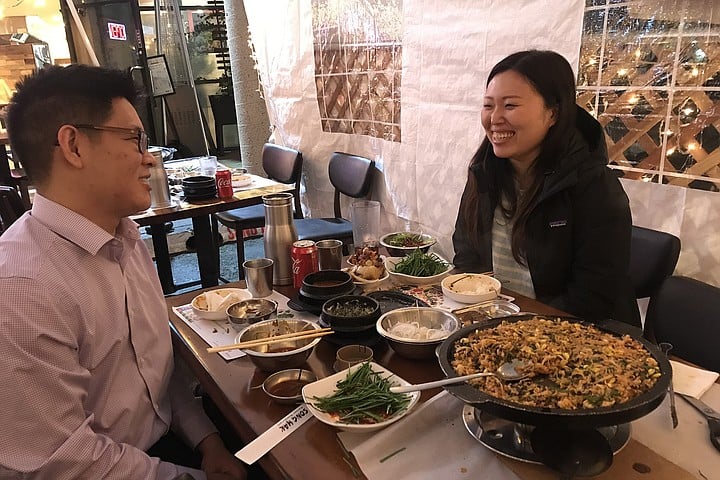
“You’re missing the main point of this restaurant,” says this gal from the table against the tent wall. Sally. She was born in South Korea. “This restaurant is about intestines. That’s why people come here. It’s a very Korean thing.”
“Uh, intestines?” I hadn’t even looked. That part of the menu is, well, up there, price-wise. But, sure enough, they have a whole intestine section, starting with gop chang, “small intestine.” For $27.95, it says you get a meal that’s not just tasty, but really good for you. “Rich and buttery, yet packed with the vitamins and minerals that help building immunity and burning fat. It is also considered as a hangover cure.”
Hey hey! Right below is dae chang, large beef intestine, “a low-fat protein powerhouse... an excellent choice for first-timers.”
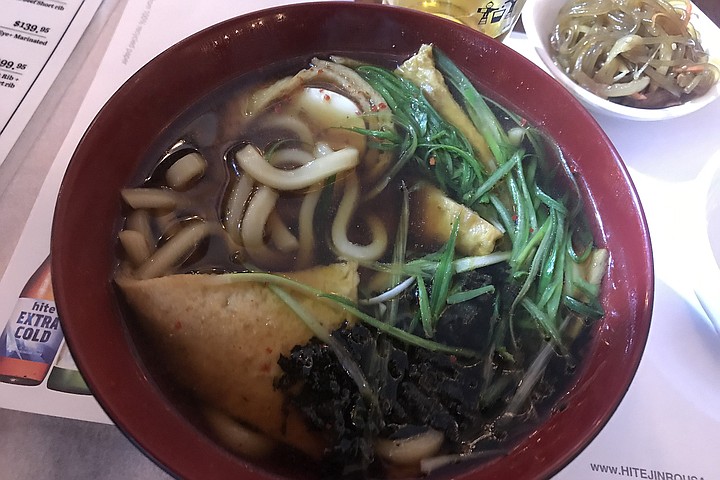
That’s a clue there, because, yes, eating these nobbly ropes of intestine can be psychologically challenging. Like, ya gotta turn your imagination off.
“Here, try some of ours. We’re full,” says Sally. She and Lawrence, who’s from Taiwan, have still-sizzling small and large intestines, cut into chunks.
Wow. Beautiful. I do. I shovel some of each into my bowl.
And here’s the thing. They both have been seared till their crisp, brown skin cracks when you chew into it, but then their interiors are still soft and almost juicy. Crunchy, buttery, fatty, salty, ideal to go with my Kloud beer. And actually, the large intestine chunks have even more flavor than the small. More garlicky, and yes, slightly more like liver, kidney, organs. But with each crunch and squelch and chew — they are chewy, but not leathery — you want to go to your beer, or soju, Korea’s sweet-potato and rice liquor. It’s ideal drinking food!
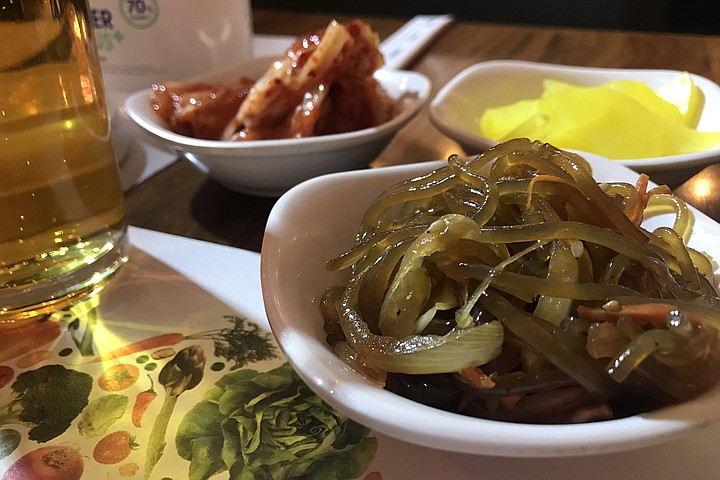
“It is very fatty,” says Sally. She holds up a mug of drippings they have collected from the gopchang and daechang chunks they have eaten already.
Of course the problem is, these ain’t cheap. Twenty-eight, thirty bucks each plate, or for a combo deal with three different types of intestine, enough for two people, we’re talking $56. Or $76 to feed four. But at this stage, you ain’t thinking cost. You’re thinking culture. It’s like eating a haggis in Scotland after a lot of whiskey on Robbie Burns’ day. As my Scottish friend Annie says, you just do it for patriotic reasons.
Whew. Get up to go. I can just imagine this-all being served up at one of Clive’s pochangmachas, drinking soju, and chomping udon noodles, or even better, gop chang.
Note to self: come back with 12 closest friends. Don’t have any appointments next day.


I have this noodle idea in my noodle. Korean noodles. I was up here on Convoy looking for the kind of “glass noodles” that my friend Clive, who was stationed in Korea, says are i) ancient, like, they’ve been made and eaten in Korea for around 7000 years; and ii) have a certain slightly sweet flavor, because they’re made from sweet potato starch; and iii) “You’ve got to have them at one of the pochangmachas, the sidewalk stalls that have all the best street food.” Best I can do is Little Seoul, up here in Kearny Mesa. And even though this is Monday night, man! Place is crowded.

I cross Convoy, and guess what? In a tent outside a place called Song Hak (which doesn’t sound so romantic, but actually means something wildly romantic like “Crane Landing in a Pine Tree”), I see a waitress handing out a little bowl of glass noodles (plus kimchi and yellow radish) as sides to chunks of beef smoking on a black iron disk sitting atop a flaming burner.
Oh yeah. The whole thing of Korean BBQ. It’s so famous, with grills built into the table you sit at, or on portable grills they bring to your table, I’m avoiding that now. Just looking for anything cheap. And wanting to stay here, because the lights in the tent make it look so danged attractive as day fades. Lucky for me: their menu has a ton of individual dishes in the $10-$12 range.
I sit down at a table in the tent. Lots of smoke from hot plates. There is so much tempting BBQ on the menus, including japchae, which is my glass noodles in chopped pork and vegetables. Cost $16.95. Or bulganjang dak gui, broiled and wok-fried chicken with spicy sauce ($18.95). Or teok galbi, grilled beef short rib patties ($16.95 for lunch, $19.95 for dinner), which look kinda like burger patties. Or suuyuk jupsi, steamed beef and pork slices with a garlic chive dipping sauce ($18.95).

But then, whew, we come down to street food, which is nearer my kind of price. Bibimbop, of course, the famous rice bowl mixed with vegetables and an over easy egg on top costs $11.95 (or $13.95 for dinner). You can add beef or pork bulgogi topping for $4.
So yes, we’re talking a meat-centric diet here. And for the real bargains, we’ve got to look at the big fat udon wheat noodle dishes at the bottom of the page, specially pocha udon. Pocha’s kind of a thing in Korean culture. This is your basic Korean street udon noodle soup. Costs $10.95. So, okay, I came for glass noodles, but as they say, there’s many a slip ’twixt cup and lip. I order the pocha udon, along with a Kloud all-malt Korean beer ($7.95 for a big bottle).
Street food it is. It’s a savory soup with a sweet flap of fish cake drowning in the brown liquid, udon (wheat) noodles swimming below, various veggies, a clump of green onions, and a large half egg. It’s good and interesting, and a reasonable deal for eleven bucks.
Only trouble?

“You’re missing the main point of this restaurant,” says this gal from the table against the tent wall. Sally. She was born in South Korea. “This restaurant is about intestines. That’s why people come here. It’s a very Korean thing.”
“Uh, intestines?” I hadn’t even looked. That part of the menu is, well, up there, price-wise. But, sure enough, they have a whole intestine section, starting with gop chang, “small intestine.” For $27.95, it says you get a meal that’s not just tasty, but really good for you. “Rich and buttery, yet packed with the vitamins and minerals that help building immunity and burning fat. It is also considered as a hangover cure.”
Hey hey! Right below is dae chang, large beef intestine, “a low-fat protein powerhouse... an excellent choice for first-timers.”

That’s a clue there, because, yes, eating these nobbly ropes of intestine can be psychologically challenging. Like, ya gotta turn your imagination off.
“Here, try some of ours. We’re full,” says Sally. She and Lawrence, who’s from Taiwan, have still-sizzling small and large intestines, cut into chunks.
Wow. Beautiful. I do. I shovel some of each into my bowl.
And here’s the thing. They both have been seared till their crisp, brown skin cracks when you chew into it, but then their interiors are still soft and almost juicy. Crunchy, buttery, fatty, salty, ideal to go with my Kloud beer. And actually, the large intestine chunks have even more flavor than the small. More garlicky, and yes, slightly more like liver, kidney, organs. But with each crunch and squelch and chew — they are chewy, but not leathery — you want to go to your beer, or soju, Korea’s sweet-potato and rice liquor. It’s ideal drinking food!

“It is very fatty,” says Sally. She holds up a mug of drippings they have collected from the gopchang and daechang chunks they have eaten already.
Of course the problem is, these ain’t cheap. Twenty-eight, thirty bucks each plate, or for a combo deal with three different types of intestine, enough for two people, we’re talking $56. Or $76 to feed four. But at this stage, you ain’t thinking cost. You’re thinking culture. It’s like eating a haggis in Scotland after a lot of whiskey on Robbie Burns’ day. As my Scottish friend Annie says, you just do it for patriotic reasons.
Whew. Get up to go. I can just imagine this-all being served up at one of Clive’s pochangmachas, drinking soju, and chomping udon noodles, or even better, gop chang.
Note to self: come back with 12 closest friends. Don’t have any appointments next day.